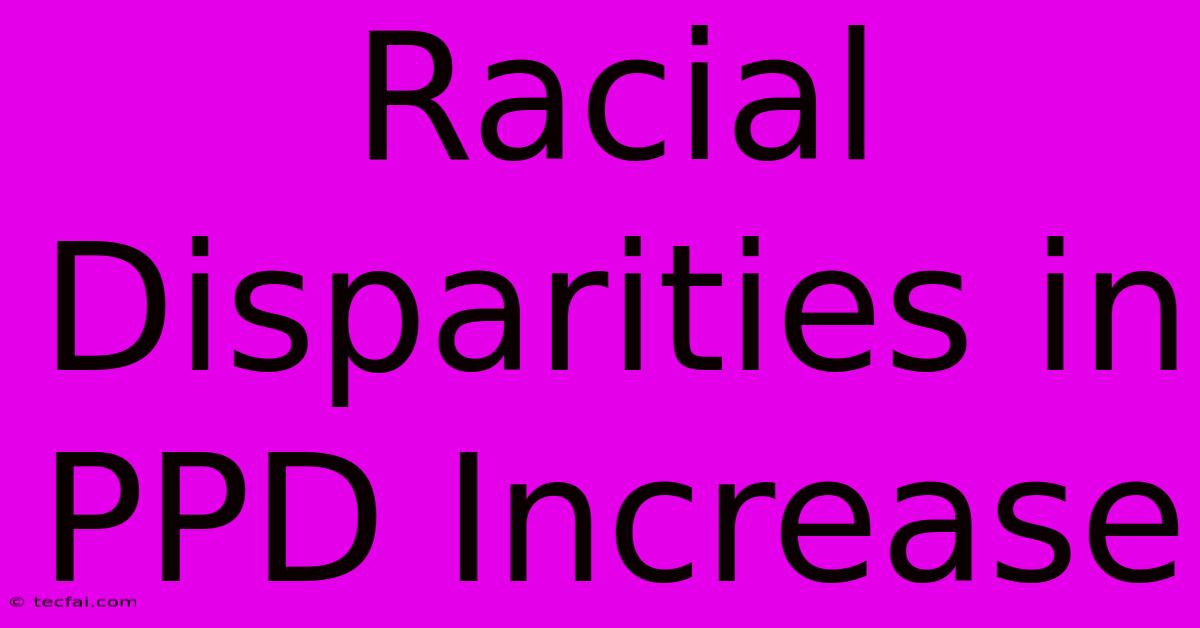Racial Disparities In PPD Increase

Discover more detailed and exciting information on our website. Click the link below to start your adventure: Visit Best Website tecfai.com. Don't miss out!
Table of Contents
Racial Disparities in Postpartum Depression Increase: Understanding the Complexities
Postpartum depression (PPD) is a significant public health concern, affecting a substantial number of women after childbirth. However, research consistently reveals a troubling reality: racial disparities in PPD prevalence are stark and demand immediate attention. This disparity isn't simply about differing rates; it speaks to a complex interplay of social determinants of health, access to care, and systemic biases within the healthcare system itself. Understanding these complexities is crucial for developing effective interventions and achieving health equity.
The Stark Reality: Higher Rates Among Certain Racial Groups
Studies have shown that women of color, particularly Black and Latina women, experience significantly higher rates of PPD compared to white women. This isn't a matter of individual predisposition, but rather a reflection of the societal burdens these women face. While the exact reasons are multifaceted and require further research, several key factors contribute to this disparity:
1. Socioeconomic Factors and Stress:
- Financial Strain: Financial insecurity, often disproportionately affecting women of color, is a major stressor contributing to PPD. The anxieties of providing for a family, coupled with the physical and emotional demands of motherhood, can exacerbate mental health challenges.
- Housing Instability: Lack of stable and safe housing adds another layer of stress, impacting both maternal and child well-being. This instability can hinder access to crucial resources and support systems.
- Systemic Racism: The ongoing impact of systemic racism, including discrimination in housing, employment, and education, creates chronic stress that significantly increases the risk of PPD. This constant exposure to microaggressions and overt discrimination takes a significant toll on mental health.
2. Access to Healthcare and Quality of Care:
- Healthcare Disparities: Women of color frequently face barriers to accessing quality healthcare, including limited insurance coverage, lack of culturally competent providers, and geographical limitations. These barriers significantly impact the early identification and treatment of PPD.
- Bias in Healthcare: Implicit bias among healthcare providers can lead to misdiagnosis, undertreatment, or dismissal of PPD symptoms in women of color. This can stem from stereotypes and assumptions about race and mental health.
- Lack of culturally sensitive care: Treatment approaches must be tailored to the individual's cultural background and beliefs to be effective. A lack of culturally sensitive care can lead to decreased engagement and poorer treatment outcomes.
3. Social Support and Community Resources:
- Social Isolation: Social support networks play a vital role in mitigating the challenges of motherhood. However, systemic factors can lead to social isolation and limited access to supportive communities for women of color.
- Cultural Stigma: The stigma surrounding mental illness, particularly in some communities, can prevent women from seeking help or openly discussing their struggles. This stigma is often amplified for women of color due to intersecting social factors.
Addressing the Disparity: A Multi-pronged Approach
Tackling racial disparities in PPD requires a multifaceted strategy that addresses both the individual and systemic levels:
- Increased Access to Affordable Healthcare: Expanding access to affordable and culturally competent healthcare services is paramount. This includes addressing insurance coverage gaps and increasing the number of mental health professionals trained in perinatal mental health care.
- Culturally Sensitive Interventions: Developing and implementing culturally sensitive interventions that consider the unique experiences and needs of women of color is essential for effective treatment. This includes incorporating traditional healing practices where appropriate and building trust within communities.
- Addressing Systemic Racism: Addressing the root causes of systemic racism and its impact on the lives of women of color is crucial for long-term change. This necessitates policy changes that promote social and economic justice.
- Community-Based Support: Strengthening community-based support networks and resources can provide crucial social support and access to resources for mothers facing challenges. This includes creating spaces for peer support and promoting culturally relevant community initiatives.
- Raising Awareness and Reducing Stigma: Raising public awareness about PPD and reducing stigma surrounding mental illness, particularly within communities of color, is critical. Open conversations and education can empower women to seek help and support.
By understanding the complex interplay of factors contributing to racial disparities in PPD and adopting a holistic approach, we can work towards a future where all mothers have equal access to quality care and the support they need to thrive during the postpartum period. This is not merely a healthcare issue; it's a matter of social justice and equity.

Thank you for visiting our website wich cover about Racial Disparities In PPD Increase. We hope the information provided has been useful to you. Feel free to contact us if you have any questions or need further assistance. See you next time and dont miss to bookmark.
Featured Posts
-
Economists Open Letters Underwhelming
Dec 03, 2024
-
Namatay Si Yeontan Alaga Ni V Ng Bts
Dec 03, 2024
-
Update Presyo Ng Gasolina Diesel Kerosene Dec 3
Dec 03, 2024
-
Entron Exx Sistema Ng Ulvac Para Sa Semiconductors
Dec 03, 2024
-
Horse Racing Tips Monday Ffos Las Plays
Dec 03, 2024
